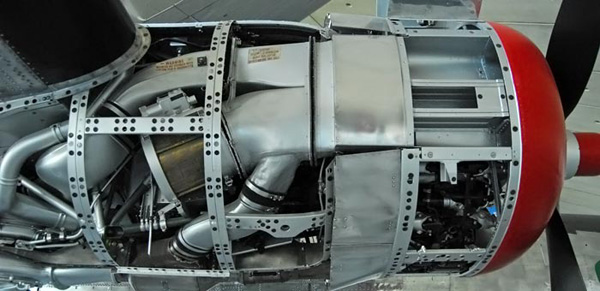
|
Consolidated B-24 Liberator |
 |
||||||||
|---|---|---|---|---|---|---|---|---|---|---|
 |
 |
 |
 |
 |
 |
 |
 |
 |
 |
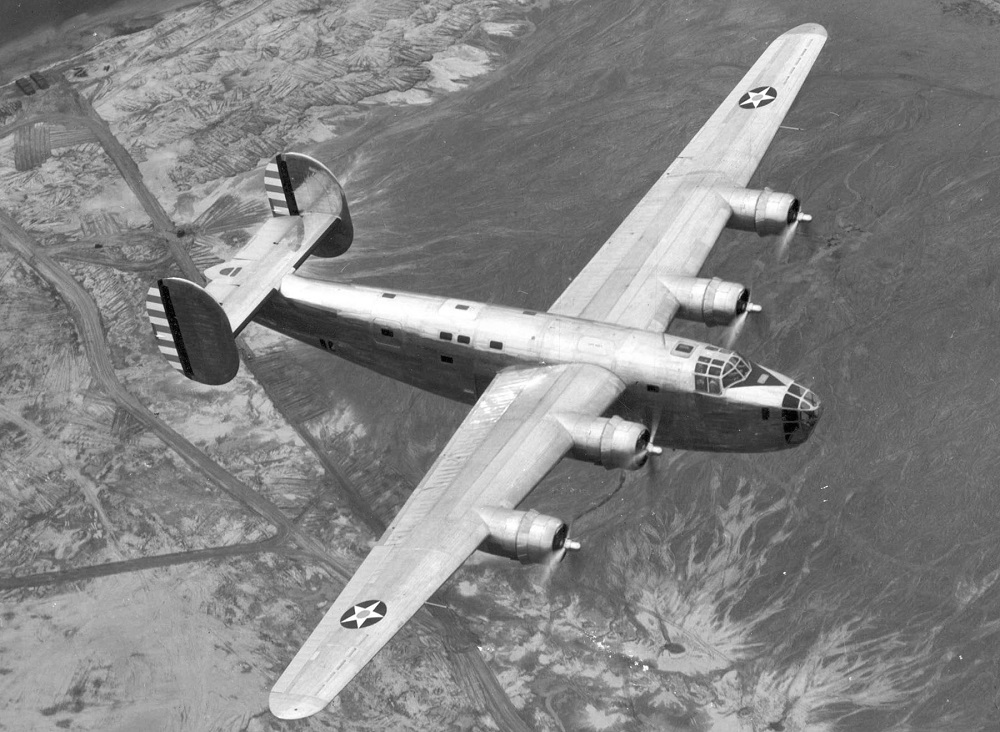 |
|
On 29 December 2019, the Consolidated B-24 Liberator, one of the most famous bombers of World War II, turned 80 years old. More than 18,400 of this type were built, making it the most produced American wartime aircraft. It gained a distinguished war record with operations in the European, Pacific, African and Middle Eastern theaters. It followed in the footsteps of the other great American WW II heavy bomber, the Boeing B-17 Flying Fortress, but it did have its critics. Its flying characteristics were not as refined as the B-17 despite the following improvements: |
|
• A longer range. • A higher top speed. • A heavier bomb load. • Tricycle landing gear. • A quantum leap in wing design and performance. |
|
Additional Notes: |
If you can see the video controls but the video doesn't play click the link below. |
|
In 1938, the United States Army Air Corps (USAAC) sent a request to the Consolidated Aircraft Corporation to become a second source for Boeing B-17s. In response, President Rueben Fleet of Consolidated sent two aides, I. M. Laddon and C. A. Van Dusen to the Boeing factory in Seattle, Washington. After the visit, Rueben Fleet decided that he didn’t want to produce a design that was already four years old. He wanted to build something new and it was about the same time, the USAAC had issued Type Specification C-212 for a new bomber with the following requirements:
• 300 mph (483 km/h) airspeed. Instead of building Boeing B-17s, Reuben Fleet offered to build an entirely new aircraft to meet the new specifications, resulting in the Model 32. The wing and flaps of the Model 32 would be virtually identical to the high aspect-ratio Davis wing that had been successfully used on the Model 31 flying boat.1 A mockup was built in two weeks using parts previously used on the Model 31 that included the Davis wing and the tail from the Model 31. The design of the engine nacelles would be the same as the PBY Catalina. The fuselage was an all new design with two bomb bays, both the same size as the B-17.
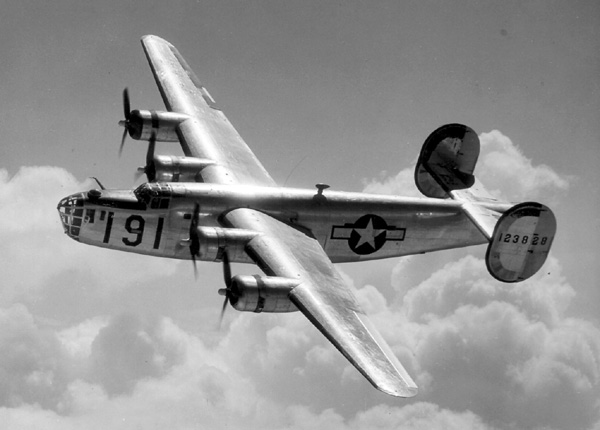 The B-24 had two bomb bays, both the same size as the B-17.
The B-24 had two bomb bays, both the same size as the B-17.A contract was awarded in March 1939 for an additional wooden mockup, one wind tunnel test model and one XB-24 airplane. There was a requirement that the airplane had to be ready before the end of the year and Consolidated just met the deadline when the first prototype made its inaugural flight on 29 December 1939. The first flight lasted just seventeen minutes.2 The Davis wing demonstrated such remarkable performance on the Model 31 flying boat and early flights of the XB-24 that orders were coming in even before production had started. The USAAC ordered seven YB-24s and twenty B-24As. The first production aircraft were export versions with deliveries beginning in December 1940. The export version was designated as the LB-30 with LB signifying Land Bomber. 120 LB-30s were ordered for France and 164 were ordered by the British.3 Orders for France were not available before its capitulation and the French aircraft were diverted to Britain.4 The top airspeed of the XB-24 was 273 mph (440 km/h) and failed to meet the USAAC requirement of 300 mph (483 km/h), but range was the primary concern of the Consolidated team. The engine on the prototype was the Pratt & Whitney R-1830-33 Twin Wasp with a mechanical supercharger. When the engines were upgraded on the XB-24B, to the R-1830-41 with turbo-superchargers, airspeed increased to 310 mph (499 km/h).5 The Model 32 had a wingspan six feet greater than the B-17 Flying Fortress, but despite being longer, the wing area was 25% less than on the B-17. The high aspect-ratio wing reduced drag and provided greater fuel efficiency, but there was a tradeoff. The B-24’s wing loading was 35% higher than the B-17. The highly efficient airfoil was not as durable as the wing of the B-17, and could not withstand much damage and continue to fly. Although the wing of the B-17 was less efficient, it was perceived to withstand greater battle damage and still get its crew back home.
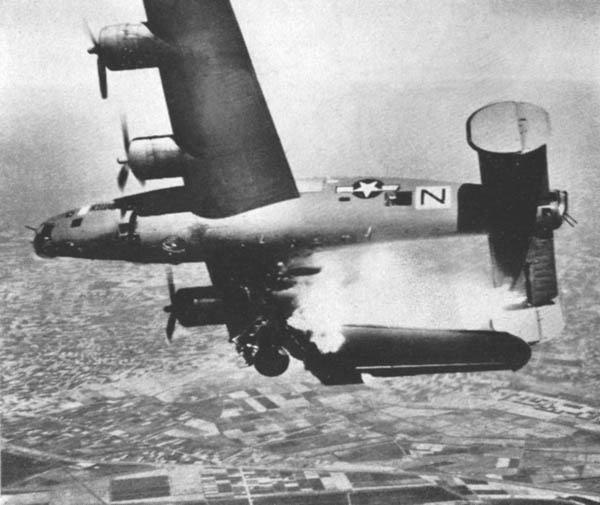
|
| Flak was a serious problem for the B-24 Liberator. The accuracy and concentration of flak over Europe was never contemplated during the design of the B-24. Germany was particularly good at delivering flak, which became very accurate after the development of radar guidance systems. Also, German fighters would fly up to the level of the bombers and report the altitude of the bomber formations. Allied bomber squadrons used evasive maneuvers to avoid flak, but the bomber streams remained very vulnerable to the devastating effects of flak. Also, the B-17 could fly higher than the B-24. B-24s flying at 2,000 to 3,000 ft. below the B-17s, offered better targets for the flak guns. |
|
The original B-24s had integral fuel tanks to save weight and construction costs.6 They also lacked self-sealing equipment, making them more fire prone than the B-17. The B-24s that were built at the Willow Run plant, were prone to leaking, because strict temperatures for the building were supposed to be kept within a range of six degrees. Because this criterion was not followed, the aluminum in the planes produced minute cracks, which created leaks. To correct the leaks, bladder tanks had to be installed in the wings which increased weight and reduced the operating range.7 It was rumored that Luftwaffe pilots, who if given a choice, would prefer to attack the B-24 over the B-17. Self-sealing tanks were a US Army requirement and were installed in USAAF aircraft.8
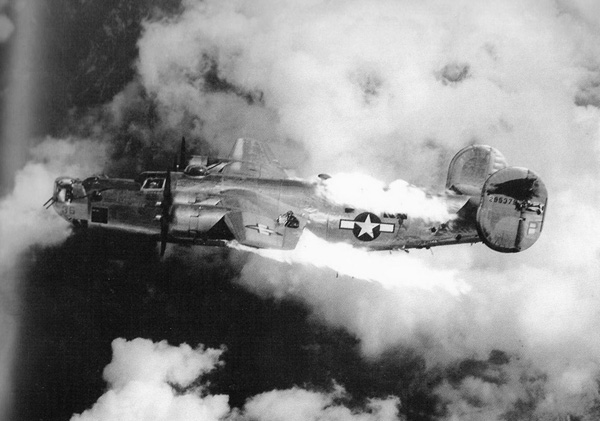
The B-24 was less comfortable than the B-17 and idle gunners had to sit on the floor. It was also colder and spot heaters were inadequate—drafts seemed to be everywhere. Equipment was added to the B-24, whereas on the B-17 it was built in. Moving around the B-24 was awkward when wearing full gear and jarring collisions were often encountered with aircraft structures and installed equipment. During fuel transfers, the cabin would fill up with gasoline fumes and the bomb bay doors would have to be cracked open to clear the fumes. The differences in comfort have been attributed to the fact that the development of the B-24 occurred during wartime, where quantity becomes more important than quality. Whereas, the B-17 was developed during peacetime, which allowed more time to work out many of the bugs out before going into service. The B-24 also had a higher accident rate than the B-17, which was giving it the reputation of a widow maker. In 1943 alone, 850 Second Air Force crewmen were killed in 298 B-24 accidents. But accidents were common in the rush to development, and this was also a problem with the introduction of the P-38 Lightning, P-47 Thunderbolt, B-26 Marauder and B-29 Superfortress. The B-24 in Combat: In Europe, Bomber Command of the Royal Air Force concentrated mainly on night bombing, while the United States Army Air Force operated primarily as a day bombing force. On 4 December 1942, US Liberators of the 9th Air Force attacked Naples, recording their first raid on Italy. This was followed by 270 Liberators and B-17 Flying Fortresses making the first raid on Rome on 19 July 1943. The USAAF casualties were among the highest for bombing forces. This was well illustrated on 17 August 1943 when 59 bombers were shot down, attacking German ball-bearing factories, during the Schweinfurt–Regensburg mission. This was followed by "Black Thursday" when 60 out of 220 bombers were lost during the second raid on Schweinfurt on October 14th. On 6 March 1944, a force of 750 B-24 Liberators and B-17 Flying Fortresses attacked Berlin in daylight. 68 did not return.9 Bomber losses decreased with the perfection of formation flying and the support of long-range escort fighters, such as the P-51 Mustang. Incredibly, Liberators are recorded as having dropped over 630,000 tons of bombs, while several thousand enemy aircraft fell to their guns.
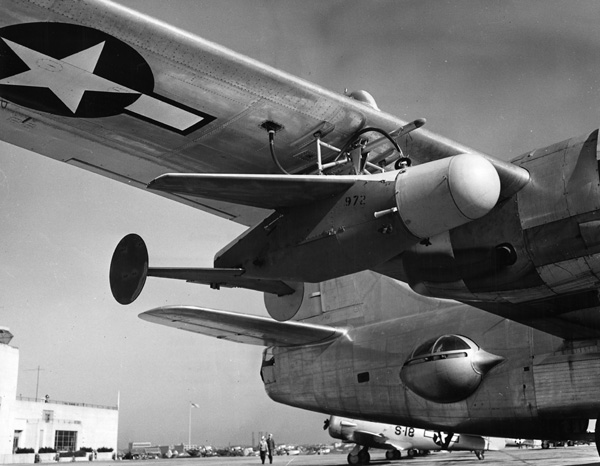 A PB4Y Privateer carrying a Bat guided bomb. The B-24 became the natural choice for the war in the Pacific. Its faster speed gave it an advantage. In Europe, speed was less important than flying a tight formation. While in the Pacific, speed was more important and formation flying less. Flak was also less of a factor than it was in Europe and its long range allowed for greater access to distant targets. Some B-24s were converted to carry the first US air-to-surface, radar-guided missile called the Bat and in April 1945, a Bat sank a Japanese naval destroyer. Construction: It is difficult to generalize about the B-24 models as compared to other aircraft. As production expanded, versions appeared with varying armament and other differences. There were five different manufacturers and many planes went to mod centers after they rolled off the assembly lines. While the differences may seem slight today, they weren't at the time. Mechanics in the field had to deal with four major variations and four sets of manuals. The B-24 had 1,820 engineering changes or an average of 3.6 for every aircraft produced—more than any other WW II aircraft. B-24s were constructed at the following locations:
• Consolidated - Fort Worth, Texas. The first production Liberators were six LB-30s (ex USAAC YB-24s) and lacked self-sealing fuel tanks. They were used as transatlantic Return Ferry Service airliners with BOAC. The British were receiving a lot of aircraft from the United States and Canada. This was followed by twenty RAF Liberator Is for Coastal Command as patrol aircraft. The USAAC delayed their order to take delivery of more advanced models. Although twenty were ordered, only nine B-24As were built as well as nine B-24Cs. The B-24D was the first main production model with 2,728 aircraft produced. The "D", "E" and "G" were essentially the same aircraft, totaling 3,958 aircraft.10 Although some sources credit the North America, Dallas built B-24G-1-NT as having the first nose turret, this distinction actually belongs to the first production Ford built B-24H model (c/n 42-7465). The emphasis here is "production" model. Earlier B-24s had nose turrets, but these were installed as field modifications. The nose turret contained two .50 caliber machine guns for frontal protection and increased the B-24 length to 67 feet 2 inches (20.47 m). The Sperry ball turret became standard equipment on the B-24G and following models.
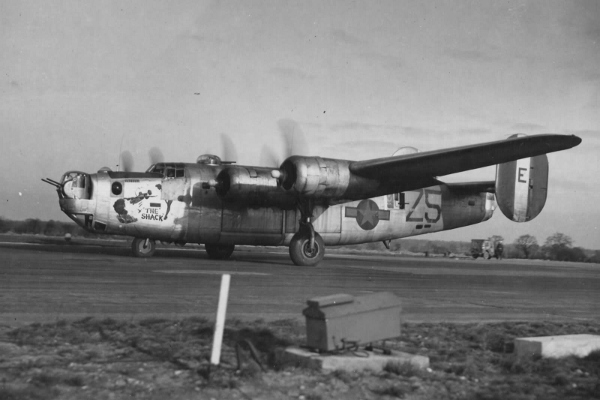 The B-24J. The B-24J was produced in greater numbers than any other series and was the only version produced in all five plants. In the San Diego plant, it went from producing the “D” straight to the “J.” The main difference between the D-CO and the J-CO was the addition of the Consolidated A-6A nose turret, which was almost identical to the tail turret. Other defensive armament included the Martin A-3C upper turret, Briggs A-13 ball turret and flexible 0.50 caliber machine guns at the open window waist positions. A total of 6,678 B-24Js were built. The 1,667 B-24Ls and 2,593 B-24M models varied only slightly in armament fixtures from their predecessors. The main change was going from the open window waist guns to enclosed blister windows. This addition definitely had to make the airplane more comfortable. There were a variety of different tail turrets. It was decided that B-24Js would be delivered to modification centers without tail turrets installed and small batches of aircraft could be tailored to the needs of theater that they would be delivered to. B-24s from San Diego were designated B-24L, Ford's aircraft were designated B-24M and North American planes were designated B-24N. However, this caused some confusion and some Ford B-24Ms planes were later designated as B-24Ls.
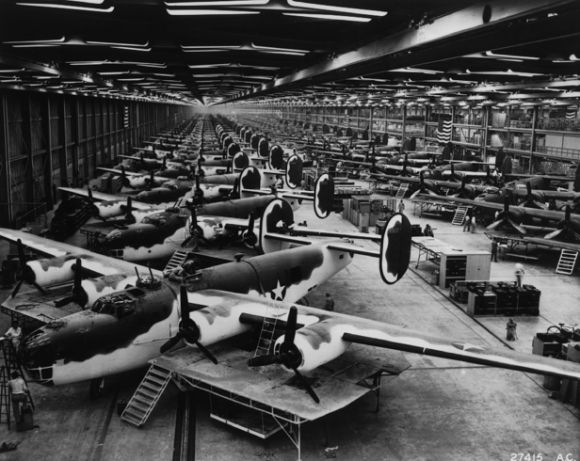 Production reached one airplane every 100 minutes, seven days a week. By March of 1944, Ford was producing one B-24H every 100 minutes, seven days a week. The supply of aircraft started to exceed the USAAF's ability to use them, which was becoming a source of embarrassment for the USAAF. By mid-1944, the San Diego and Willow Run plants were capable of delivering more than enough B-24s and the Douglas at Tulsa and North American at Dallas lines were terminated. Fort Worth continued to build B-24Js until the end of the year. On January 1, 1945, there was a pool of over 900 aircraft in storage waiting for modifications at mod centers. By VJ-Day, this was reduced, but still over 400 aircraft were awaiting modifications when the war ended. Many of these aircraft were flown straight from the factory to the dessert and eventually wound up on the scrap heap without ever seeing service.
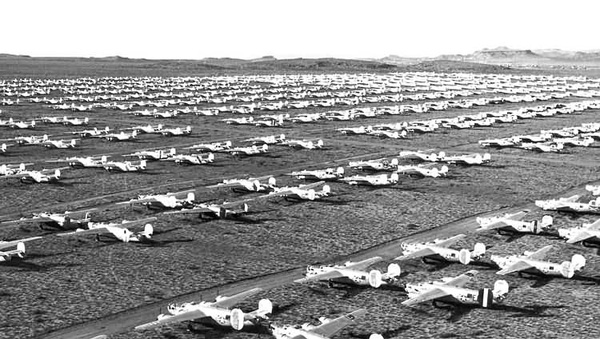 Notes on the Engines: The B-24 was powered by a 1,200 hp (900 kW) Pratt & Whitney R-1830-35 or -41 turbosupercharged radial engine. The turbo-supercharger was placed on the lower surface of the engine nacelle and the oil cooler and supercharger ducting were placed on either side of the engine. Looking forward, the right side of the cowl contained the supercharger, generator and oil cooler ducts. The left side contained the intercooler ducts.11 The oval shaped engines would become one of the Liberator's characteristic features.
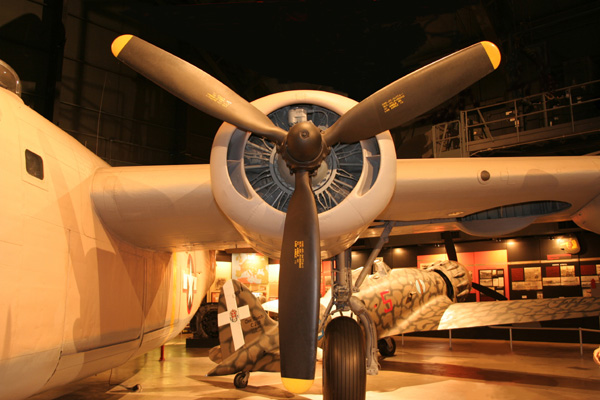 The oval shaped cowling was a characteristic feature of the Liberator.
Other Operators and Models: Besides the USAAF and RAF, Liberators also found their way into the United States Navy, the Royal Canadian Air Force and the armed forces of other countries. All USN Liberators were designated PB4Y-1s regardless of their USAAF series designation. Several B-24s were used as transports under the Air Force designation of C-87 Liberator Express and a few became C-109 fuel tankers. The B-24 had more room than the B-17 and lent itself to be more easily converted to carrying cargo or passengers. Initially B-24Ds were converted to C-87s at the Fort Worth assembly line and were operated under the designation RY-1 and RY-2. A built-up floor section replaced the bomb bay doors and the passenger version carried from 21 to 25 passengers. As C-54s became more available, the C-87s were retired. As C-109s, the B-24 was stripped of all its hardware and eight auxiliary fuel tanks were installed in the fuselage. This gave the aircraft a total cargo load of 2,900 gallons. A large scale conversion program ensued to fuel the gas hungry B-29 Superfortresses for the bombing campaign against Japan. Slightly more than 200 aircraft were converted to C-109s. After the war, some RAF GR Mk VIIIs served in the Berlin Airlift and with the United States forces, notably as an air rescue and weather reconnaissance aircraft with the Coast Guard well into the 1950s. The majority of surviving B-24s were from the Indian Air Force (IAF), which Hindustan Aircraft Limited (HAL) had salvaged. The B-24s were abandoned by the RAF after the war and were left at the Chekeri airfield in Kanpur, India. The RAF had disabled the aircraft, by smashing the airplanes with bulldozers, hacking holes in the fuselages with axes, breaking the instruments and pouring sand into the engines. Despite the damage, HAL was able to patch the aircraft sufficiently enough so that they could be ferried to HAL’s factory in Bangalore. 42 B-24s were ferried to the factory and refurbished to airworthy condition. When they were retired from the IAF, most of the aircraft were scrapped, but after calls from museums around the world, five aircraft were saved and are now in museums in the United States, Canada and the United Kingdom. |
